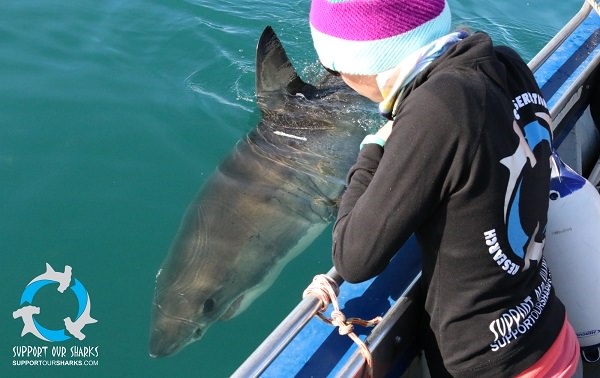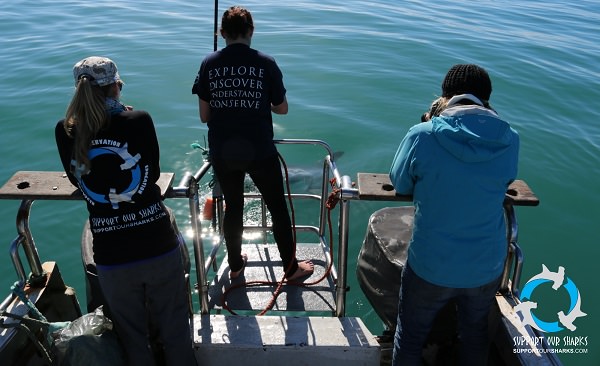with Lights and Sounds
Article by Support Our Sharks (06 Dec 2017)
 In recent years, the search for an effective
shark deterrent has intensified in the wake of highly publicized
shark bite incidents around the globe.
However, despite the increased attention given to these
incidents, research suggests that shark interactions with humans
have actually decreased.
According to a
recent study out of Stanford’s Hopkins Marine Station, shark bite risk on the
California coast has dropped by more than 91 percent since 1950.
The study, published in
Frontiers in Ecology and the
Environment, weighted the number of reported unprovoked
bites in the last 60 years in the state against the number of people
using the ocean for swimming, diving, surfing and other sports.
While the number of statewide incidents has remained
relatively steady (about one per year on average in the ’50s to
one-to-two per year now) the number of people in the ocean has
increased greatly.
Therefore, the risk of being bitten by a shark today is much lower
than it was in the 1950’s, which even then presented a very low
risk.
In recent years, the search for an effective
shark deterrent has intensified in the wake of highly publicized
shark bite incidents around the globe.
However, despite the increased attention given to these
incidents, research suggests that shark interactions with humans
have actually decreased.
According to a
recent study out of Stanford’s Hopkins Marine Station, shark bite risk on the
California coast has dropped by more than 91 percent since 1950.
The study, published in
Frontiers in Ecology and the
Environment, weighted the number of reported unprovoked
bites in the last 60 years in the state against the number of people
using the ocean for swimming, diving, surfing and other sports.
While the number of statewide incidents has remained
relatively steady (about one per year on average in the ’50s to
one-to-two per year now) the number of people in the ocean has
increased greatly.
Therefore, the risk of being bitten by a shark today is much lower
than it was in the 1950’s, which even then presented a very low
risk.
Nevertheless, with increased media attention
surrounding the few incidents that occur each year, there are
repeated calls for action to be taken to reduce what is already a
very low risk.
Unfortunately, these situations can quickly get out of hand, which
is what we saw in Western Australia (WA) in 2014 when the Government
began culling sharks in a misguided attempt to reduce the
risk to swimmers.
A
total of 172 sharks were caught (almost all tiger sharks), and eight
other animals including stingrays, however not a single great white
was caught, despite this species being identified as the one
involved in the fatal incidents that sparked the cull in the first
place.
 Given the vital role that sharks play in the
health of marine ecosystems, it is essential that we avoid
destructive control measures, such as those undertaken in Western
Australia. Instead, we
must develop non-lethal methods to allow humans and sharks to
coexist safely. As a
result, our research scientists at SOS, in collaboration with
partners at the University of Western Australia, have embarked on a
mission to test and develop non-lethal shark deterrents to provide
ocean users with an extra level of protection against negative
interactions with sharks.
Given the vital role that sharks play in the
health of marine ecosystems, it is essential that we avoid
destructive control measures, such as those undertaken in Western
Australia. Instead, we
must develop non-lethal methods to allow humans and sharks to
coexist safely. As a
result, our research scientists at SOS, in collaboration with
partners at the University of Western Australia, have embarked on a
mission to test and develop non-lethal shark deterrents to provide
ocean users with an extra level of protection against negative
interactions with sharks.
Previously, we reported the success we observed
with an electric deterrent,
the Shark Shield, which was able to effectively deter great white sharks from
interacting with a baited canister. In
our latest research, we focused our attention on the potential
effect of auditory and visual signals on shark behavior.
We were interested to see if by simply playing a sound or
flashing a light, could we manipulate the behavior of an approaching
shark?
 The artificial
sound that we created for this
study was based on the work of
Myrberg et al. (1978),
which showed that a sound with a rapidly changing amplitude and
frequency elicited a deterrent behavior in free-swimming sharks.
In an attempt
to increase the potential deterrent effect of the audio signal, we
only activated the sound as white sharks approached within
approximately 2m of the audio source.
This was to reduce the chances of the sharks habituating to
the sound as they approached from a distance.
Nevertheless, we did not
observe a significant deterrent response to the artificial sounds
presented. Neither did we
observe any significant deterrent response when the sharks were
presented with a flashing strobe light.
However, when the auditory and visual stimuli were presented
in combination, white sharks spent significantly less time in close
proximity to the bait.
Furthermore, this effect was even more pronounced in smaller benthic
shark species that we tested.
The artificial
sound that we created for this
study was based on the work of
Myrberg et al. (1978),
which showed that a sound with a rapidly changing amplitude and
frequency elicited a deterrent behavior in free-swimming sharks.
In an attempt
to increase the potential deterrent effect of the audio signal, we
only activated the sound as white sharks approached within
approximately 2m of the audio source.
This was to reduce the chances of the sharks habituating to
the sound as they approached from a distance.
Nevertheless, we did not
observe a significant deterrent response to the artificial sounds
presented. Neither did we
observe any significant deterrent response when the sharks were
presented with a flashing strobe light.
However, when the auditory and visual stimuli were presented
in combination, white sharks spent significantly less time in close
proximity to the bait.
Furthermore, this effect was even more pronounced in smaller benthic
shark species that we tested.
As the presentation of lights or sound alone
did not show a significant deterrent effect on white sharks in this
study, we do not advise their use as a strategy for mitigating
shark–human interactions. However,
due to their potential combined effectiveness, particularly with
other species of sharks, there may be applications for this approach
in deterring specific species from fishing hooks or nets to reduce
fisheries bycatch.
We still have much to learn about how sharks
utilize their senses to perceive and interact with their
environment, but our hope is that our efforts will one day bring
about practical solutions to help humans and sharks coexist
peacefully.
You can support our research,
education, and conservation activities by making a donation here.
-----------------------------------------------
Please share your thoughts about this article below.
Other Interesting Articles:
Disclaimer
Support Our Sharks posts articles and material
prepared by other organisations and individuals not affiliated with
Support Our Sharks for educational purposes. Support Our Sharks does not
necessarily agree with the opinions expressed in such material. Support
Our Sharks also provides links from this site to the websites of
featured news articles above for informational purposes only. The links
do not imply an endorsement by Support Our Sharks of these articles or
the content of their respective web pages.
